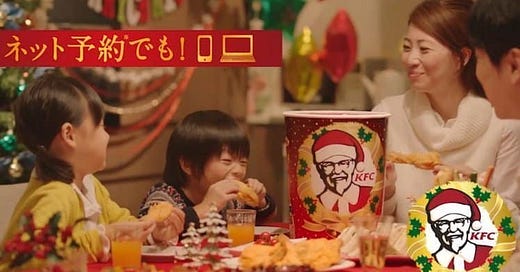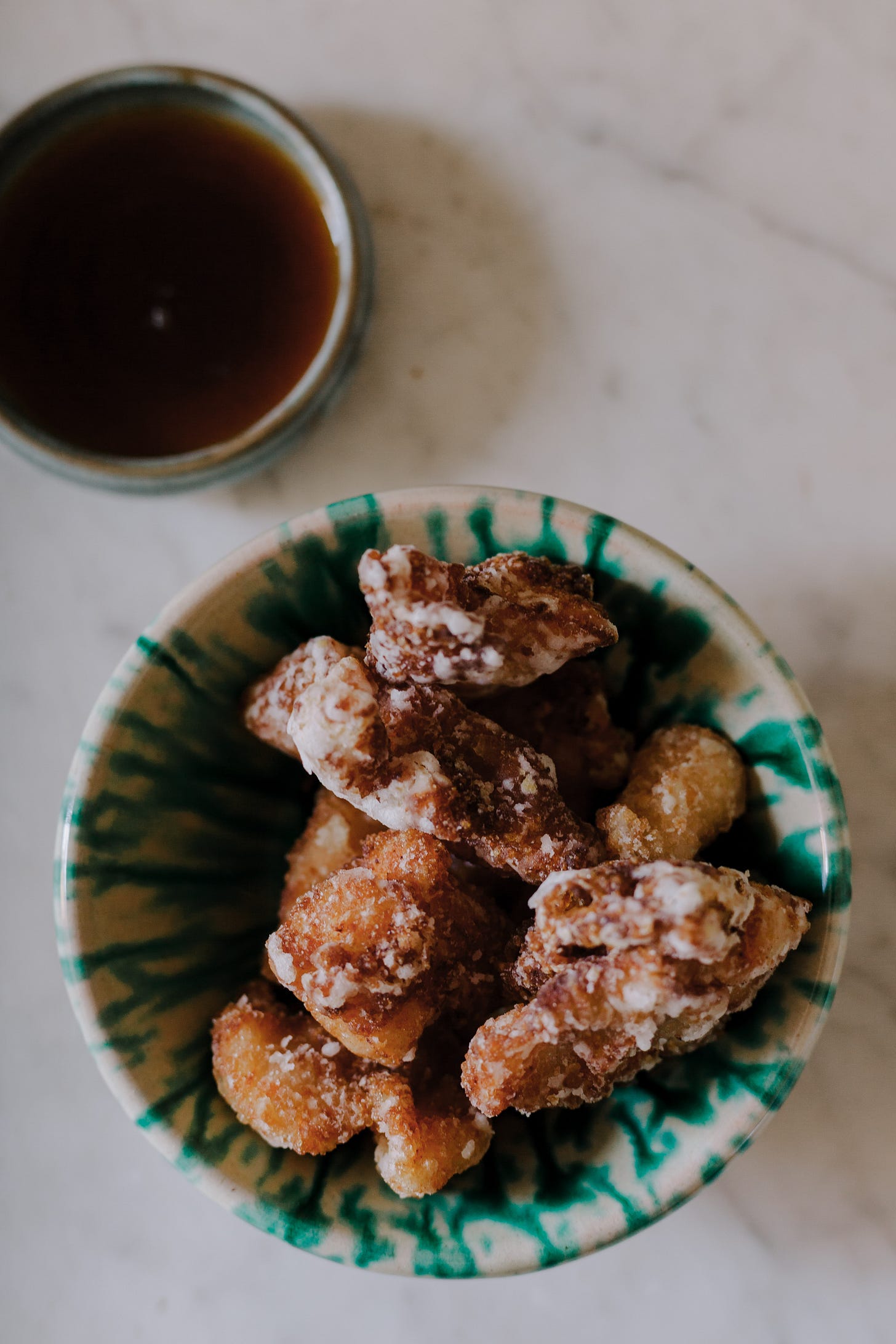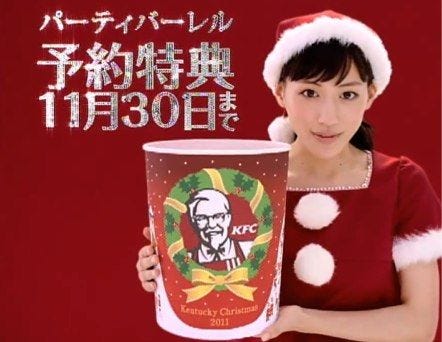KFC: the unlikely hero on a Japanese Christmas table
Behind the love of fried chicken and why fast food isn't looked down upon
Growing up with a Buddhist Japanese mother we never celebrated Christmas in Japan, and at home in Australia it was a purely cultural but not a religious event — Santa photos at the shopping centres and presents under the tree, unwrapped in our pyjamas before breakfast, then a summery long lunch featuring fresh seafood and summer fruit under the wisteria outside.
New Year’s Day is the more important Japanese celebration, a more sombre and quiet rather than celebratory event, but arguably the most important one of the year. Special foods called Osechi Ryori are made over the days leading up to New Year’s so no one has to cook on the day. One of the main ways to ring in the New Year is a deep clean of the house (literally sweeping away the bad spirits, known as osouji in Japanese, here’s more on that in the New Yorker).
But I never was really aware that some Japanese celebrate Christmas (1% of the population is Christian) and I was probably as surprised —at first— as you might be right now when I learned that the most popular way to celebrate is with a bucket of Kentucky Fried Chicken.
There are a few various stories floating around about how this all started. It was the early 70s in Tokyo. It involved some foreigners looking for something that resembled the roast turkey they were used to celebrating with on their Christmas table. The first KFC had opened in the Aoyama neighbourhood of Tokyo in July 1971 and young Japanese also found the new Western style food outlet very appealing (American culture in particular was considered so fashionable and modern).
By 1974 the first Christmas campaign by this Tokyo branch of KFC was launched and — without any Christmas traditions already in place in Japan — it took off.
According to the blog Gaijinpot, “From the Japanese perspective, particularly if you are celebrating Christmas with children, eating fried chicken together is fun and a special treat that elevates the day (which is otherwise just a typical working day) to an event.”
December 25 is not a holiday in Japan — so a large, elaborate “Christmas dinner” for those who want to partake of western holiday traditions isn’t necessarily doable. And from a purely practical point of view, many Japanese kitchens traditionally were without ovens, or if there were any, they were very small (think a toaster oven) and certainly not large enough to roast a turkey in! Most Japanese dishes are cooked on a stove top and only Western style dishes call for an oven.
Although the fried chicken bucket is the classic choice, the current KFC Christmas menu has expanded to all kinds of offerings for the Japanese palate, including pot pies, prawn gratin, a creamy Japanese mushroom chicken roll and even a whole roast chicken with kinako mushrooms and cheese stuffed under the skin.
Nina Li Coomes analyses why another reason why KFC Christmas in Japan might be appealing based on the company jingle, which she shares on Eater:
The original ads are perhaps even more revealing of the underlying emotional architecture of KFC Christmas, with a signature jingle, “Suteki na Holiday”; it means “Wonderful Holiday,” but it’s widely called the “Kentucky Christmas Song.”
「クリスマスが今年もやってくる悲しかった出来事を消し去るように
さあパジャマを脱いだら出かけよう
少しずつ白くなる街路樹を駆け抜けて」“Christmas is approaching this year again, as if to erase away
the sad things that happened. Let’s take off our pajamas now
and go outside, running through the tree-lined streets
that are turning slowly white.”At the end of each of the ads, a chorus of children’s voices shout “Mama, papa, kotoshi wa kentakkii yoyakushitene!” (“Mama, Papa, this year please reserve Kentucky!”), as if Mama and Papa forgot to reserve a barrel of Kentucky Fried Chicken last year, leaving the family disappointed and hungry. This wistfulness points back to Takeuchi’s oddly melancholy chorus, asking for Christmas to “erase away the sad things that happened.”
But why fried chicken?
Fried chicken is already a beloved meal in Japan, where they have their own karaage (above) — soy sauce-marinated pieces of chicken that are dusted in a light coating of potato starch and deep fried, and eaten with rice and pickles, as part of a larger meal or even cold in a bento box.
In Japan, fast food chains are enormously popular and, culturally, I would say also not looked down upon as “cheap” or “unhealthy”— look at the face of the Kentucky Christmas in Japan, the beloved, award-winning actress and model, Haruka Ayase.
Fast food chains are not synonymous with cheap or bad quality foods in a place like Tokyo. On the contrary, they are highly valued for their convenience, a meal that is affordable and easy to get especially for people who live alone (a growing number in Japan) and shift workers.
The quality of convenience food, whether from a 7eleven or a fast food chain is also high (anyone who has happened to try fast food in Japan or an egg sandwich from a convenient store, you’ll know, it is on another level). You can find ingredients like foie gras, fish eggs and truffles, blended seamlessly with burgers and fried chicken — these aren’t your regular fast food chains. In 2015, McDonalds even opened a fine dining pop up in Roppongi Hills in Tokyo, complete with silverware, wine glasses, white tablecloths and a five course meal featuring things like “Vichyssoise Mac fries.”
KFC itself in Japan is seen as one of the more “high end” fast food chains. And it just happened to fill a convenient hole for this (at the time) new, special, curious, Western tradition in Japan.
Thank you for being here. Wishing you and your loved ones very happy, safe and cosy holidays! Emiko x








Fascinating!
Growing up a big bucket of KFC was a definite treat. I don’t think I’ve had it in 40 years! But that karaage looks absolutely delicious ✨
Amazing!